Korg minilogue v1.2 Review
Korg’s just updated minologue to v1.2. Does the polyphonic, pint-sized analogue pack a punch? Dave Gale powers one up to find out…
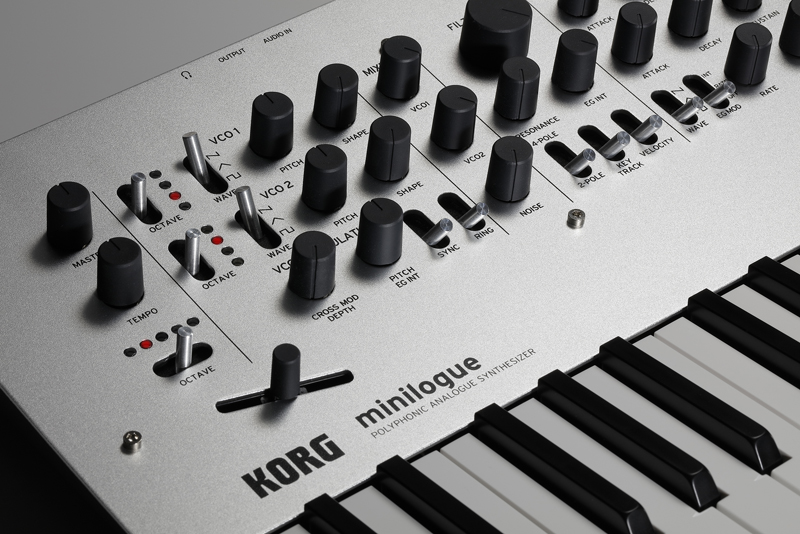

Price £469 (RRP)
Web www.korg.com/uk
At the risk of stating the obvious, analogue is having something of a renaissance at the moment. If there was ever a time to get into traditional analogue subtractive synthesis, this would be it, and that’s not just down to the wealth of equipment that has recently become available, but also the price points at which these things are appearing.
The field has its big players, such as Moog and Dave Smith Instruments, who are offering beautiful premium products, but at a premium price; however, Korg surprised us all with the release of the minilogue, announced earlier this year at the music fairs. Now updated to v1.2, with stock levels starting to rise, it’s time we put this machine under the microscope, to see what it can offer.
The Design Factor
Now I make no bones about it, I am an absolute sucker for an interesting aesthetic design, and this one is a real beauty. Upon releasing the minilogue from the box, I am immediately struck by the simple yet very striking nature of its design.
It reminds me of the original Audi TT, beautiful in its curvature and most alluring in aluminium silver, which is exactly what we have here. The front panel just sweeps away from you, in a pleasing, rising manner, with all the controls laid out on display in that common-sense way that we old-school synthesists like.
You then peer over the back to find a comprehensive and useful set of sockets; but the design doesn’t end here, as we’re treated to a beautiful wood panel, into which the sockets are sunk.
To bastardise a quote from Steve Jobs, when talking about the original iMac – the minilogue looks better from the back than many synths do from the front… Yes, I know, it should be more about how a machine sounds, of course – but actually, if you have to work with a machine on a regular basis, I believe it’s really important to be drawn in visually, and that’s why I feel that design is so important, and why it matters that the basic concept of a piece of equipment is beautiful, functional and just makes you want to sit down and work with it, so that’s where we shall go next.
Subtractive Architecture
Starting on the far left, the sonic palette begins with two Voltage Controlled Oscillators (VCOs) per voice. There is the choice of three waveforms per voice; sawtooth, triangle and square, all of which can be ‘shaped’.
You would expect this with any square/pulse wave, but the ability to also adapt the tonal characteristics of the saw and triangle waveforms is a lovely addition to the palette. The Shape pot, which turns to induce the change in tonal colour, is a little bit ‘keen’.
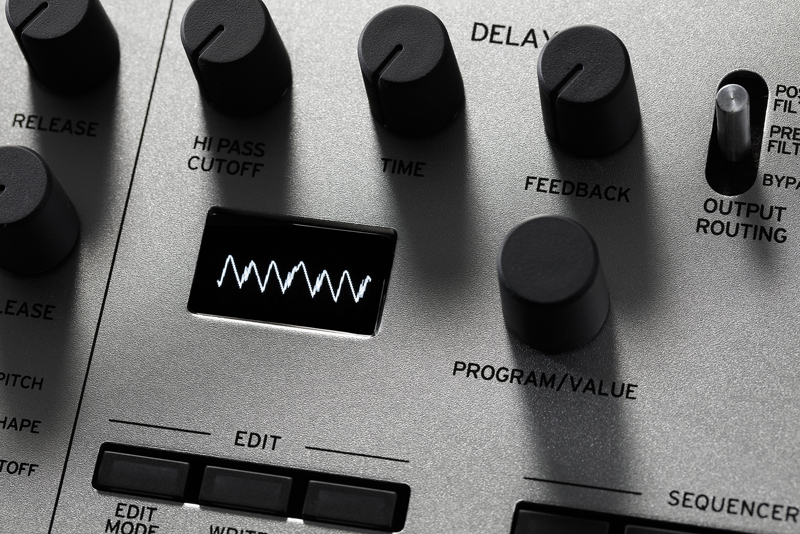
As I started to tweak, I could see things occurring on the display, yet the reflection of this audibly took a little while to kick in – although kick in it did, with a little bit of a thump. But the rest of the pot curve was pretty smooth, with little hint of any stepping, and certainly not enough to cause offence.
Bearing in mind that there are two VCOs on offer, the sound can immediately be pretty damn huge, thanks to the tuning pot, available in both VCO camps.
It’s a full sweepable affair, and will rise and fall to the tune of an octave either side, and comes into play nicely with the VCO Octave switch, which will allow for four positions of register.
As if the analogue credentials didn’t need to be rammed home even further, with both VCOs supposedly tuned to the same 0 tuning point, there was beautiful cycling occurring, as the minute drift played with the pitch. If you fancy being a little more brutish, the oscillators can be sync’d and also passed through a ring mod. Strange that both these switches need to be in the ‘up’ position to apply, rather than the ‘down’ position which one might expect.
Next to the VCOs is a mixer, allowing for the mixture of both VCOs and some welcome white noise. I know all white noise should really sound the same, but to my ears it never does and here, the noise seems pleasingly bright; perfect for those percussive whooshes that many of us enjoy.
Next up, we have the Filter section, which is a true voltage-controlled design, offering both two- and four-pole functionality, and can be driven into self oscillation in both modes – excellent. The filter can key-track to the tune of both 50 and 100 per cent, and most helpful of all, there’s a switch dedicated to the effect that the keyboard velocity will have on the filter.
Why is this a big deal? Vintage machines never had velocity control of filter, and I’ve always found it vaguely distracting, so having a switch in the heart of the filter section to turn this on or off is a blissfully simple idea many makers overlook.
The Envelope section boasts two full ADSR envelopes, which look after the usual amplitude and filter duties, the latter being linked to the Envelope Generator amount pot, located in the filter section. This helpfully works in both positive and negative polarity, thanks to the +/- polarity of the pot.
The second envelope can also be assigned to the pitch of VCO 2. Beneath the envelopes resides the LFO section, with similar options for amount and direction of modulation.
This seems like a sensible point to just take a moment to draw breath, because I can’t quite believe how much we have on offer here. What I’ve so far described is the architecture of a pretty substantial synth, the specification of which would be up there with the best of them, yet Korg has managed this with such seeming simplicity that it’s a joy to use, and use it we shall…
Having crept through a series of preset and programmed patches, I found the initialised patches, allowing me to start my sound exploration from scratch. The VCOs sound excellent, with a notably short warm-up time, and even just detuning the two VCOs makes for an enormous sound. Thanks to the wave-shaping, there is plenty of local contrast available and character in abundance. The filter is bright and punchy, and opens and closes to the extreme, giving plenty of control.
Picture This
Having drawn so much delight and inspiration from the basic architecture, we’re not done yet, not by any means. Korg has included a small OLED display, which acts as a very helpful point of reference when tweaking those sounds, but they have gone one step further and turned the OLED into an oscilloscope.
I ask you, what synthesist wouldn’t like to have an oscilloscope built into their synth? Moreover, it’s unobtrusive, and is incredibly useful as any pot is brought into play.
Korg minilogue v1.2 – In performance
Because we are dealing with a polysynth, and four voices, it brings into play all manner of performance options. There is an obvious four-voice poly mode, but there are also Mono, Duo and Unison modes, the latter of which will stack all eight VCOs (two per voice) and sound instantly huge and thunderous.
Now the Voice Depth mode will come into play. This discrete and ambiguous pot will add further colour, depending on your voice mode. In Unison Mode, detuning will occur across all eight VCOs, resulting in whopping timbres that will make the floorboards shake. In Mono Mode, this pot adds a sub oscillator – a brilliant additon!
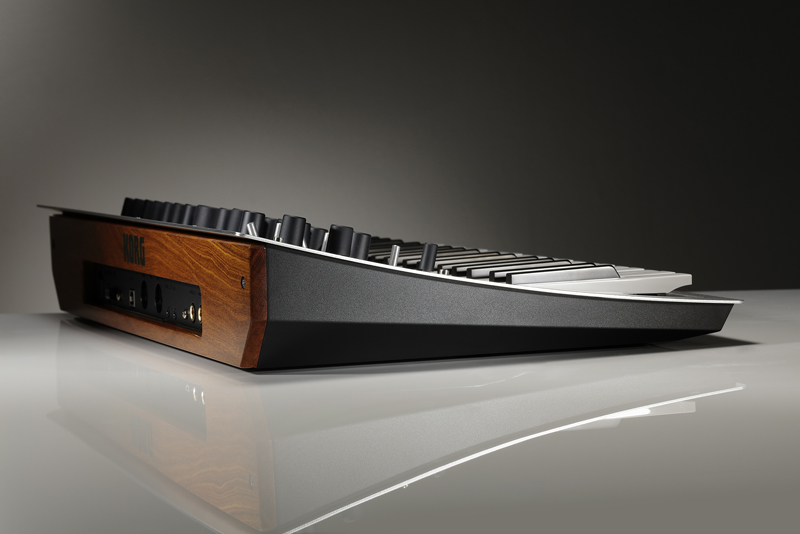 I’m getting the sense that these guys at Korg really thought about what performers would want in a synthesiser, and looked after each sensibility in turn. Alongside the manual performance possibilities, there are also a number of useful additions, including an Arpeggiator and a rather handy 16-step polyphonic sequencer.
I’m getting the sense that these guys at Korg really thought about what performers would want in a synthesiser, and looked after each sensibility in turn. Alongside the manual performance possibilities, there are also a number of useful additions, including an Arpeggiator and a rather handy 16-step polyphonic sequencer.
The sequencer is very easy to work with, thanks to the dedicated buttons on the front panel, and the multi-purpose display, which gives a guiding clue as to which step is being programmed.
This became an incredibly useful conduit for getting sequential ideas down, quickly and easily. Korg has also implemented 100 factory presets, and another 100 user locations, so storing patches will not be an issue while keeping the full factory set intact.
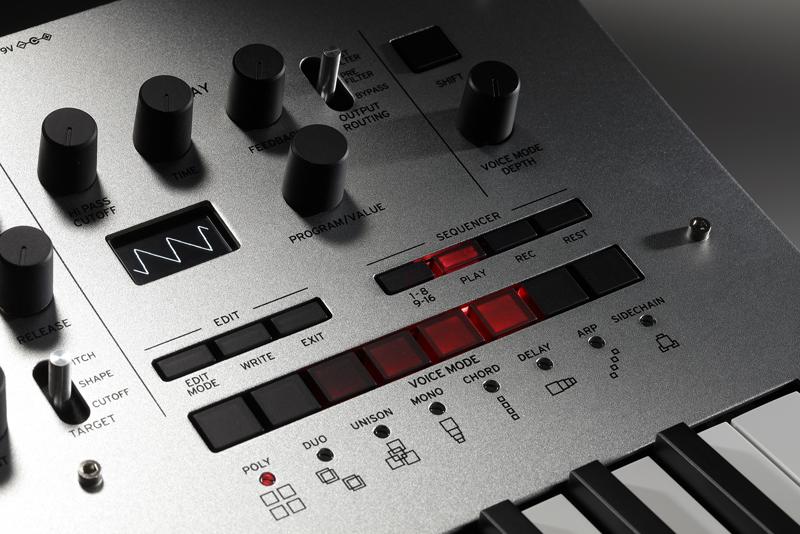
As a helpful finishing touch, Korg has also included a delay on the backend of the signal flow, which is switchable from pre- and post-filter, or bypass, and all from the flick of the dedicated switch on the front panel.
This is another suitable moment to draw breath and reflect on the fact that there are next-to-no multi-button presses to be had here. Admittedly, there are some button presses that need more clues, such as the two-button press which retunes the oscillators – but this is a huge joy to use, because there is no head scratching involved from trying to work out how to do something. You press a button, and up pops a description on the OLED display.
Yet despite the impressive performance credentials, there is a small gripe. While there is a pitch lever, there is no additional wheel or button for modulation. It is possible to assign the pitch lever to other duties, but this would take it away from the preferred ‘pitch’ assignment, which feels like a bit of a shame.
Alternatives
Roland has some good alternatives to the minilogue, but neither are fully (or at all!) analogue. The JD-XA is a 129 digital, one analogue voice machine, with multi-timbral capability and drums. You name it, it has it, but it’s also mini-key based and has come in for criticism, as the red legend on the black gloss is difficult to read.
However, the Roland Gaia SH-01 is a full-size, 64-note polysynth, albeit digital-based, but with a healthy nod to virtual analogue. This is a great synth, and certainly one to consider if you want to play live, thanks to the full-size, three-octave keyboard.
At the time of writing, Behringer is also ‘teasing’ us with a series of videos about its forthcoming synth, which we know will be DCO-based and a polysynth. See p6 for more info…
The Ins and Outs of the minilogue v1.2
As already mentioned, the back of this machine looks pretty special, with its Korg emblazoned rear-wood panel. It’s such a shame to plug in cables to spoil it, but doubtless you will need to, if you want to hear something! So, on offer are the usual options: headphone and mono audio outputs, as well as MIDI connectivity via dedicated In and Out sockets and over USB.
Audio input is also available, but for current Volca owners, there is a very handy ‘Sync’ In and Out, providing a clock pulse for immediate connection to other analogue devices, or even to allow a sync with a modular. This is a really nice touch, and a welcome one for anyone who has already managed to accumulate other analogue-friendly Korg boxes.
Korg minilogue v1.2 – Do I really need this?
If you are in line for a versatile analogue synth, this is an excellent choice, particularly if you have other analogue kit, such as Eurorack or any of the Korg Volcas. I would have to say that the creative possibilities with a Volca Beats and Bass, and a minilogue, could keep you busy for hours, with plenty to explore – and it would be unbelievable fun to use! Isn’t that why we got into synths in the first place?
minilogue v1.2 – Overview
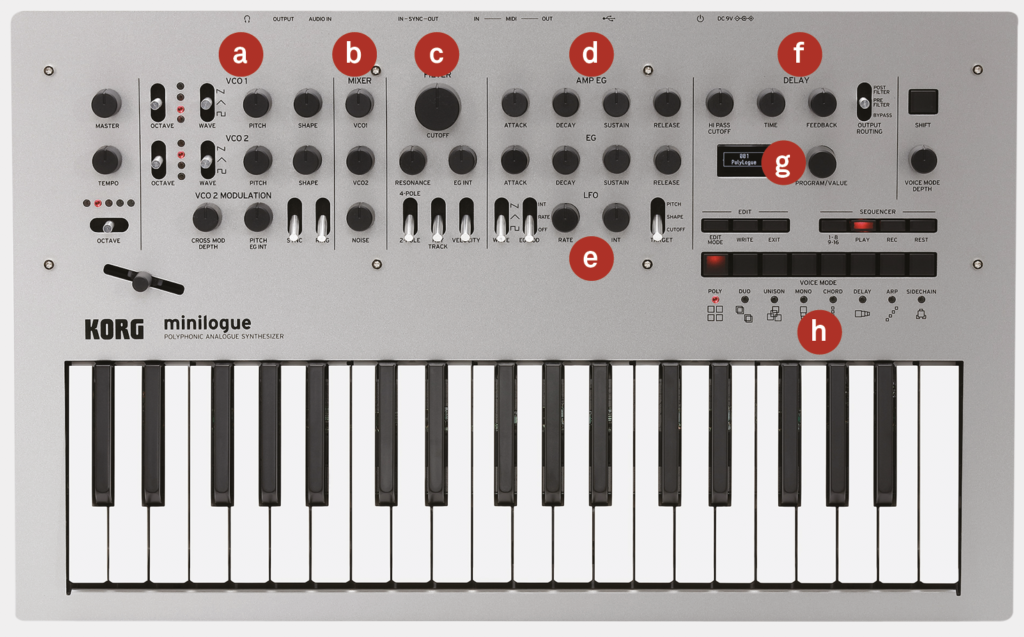
a: VCOs – The two VCOs are fully tune-able, and also offer with the ability to wave-shape both oscillators. Assignable modulation is also available on VCO 2.
b: Mixer – The Mixer section allows the blending of both VCOs, with the additional white-noise channel.
c: VCF – A fully resonant VCF, with two/four-pole selection. Velocity and tracking can be defeated easily by flicking the appropriate switch.
d: Envelopes – Two ADSR envelopes; one for amplitude and one assignable to other duties. Useful for adding VCF bite to the front of your patch.
e: LFO – A dedicated LFO, with numerous options for assignment. Three usual waveforms are selectable from the dedicated switch.
f: Delay – The in-built delay effect is a really nice addition. Easily bypassed, or assignable pre- or post-the VCF.
g: OLED Display – The beautiful OLED Oscilloscope doubles as an easy way to view parameter changes and patch selection.
h: Voice MODE – The Voice Mode menu invites numerous modes of operation. Poly to mono, it’s all very easy to change on the fly.
Conclusion
There is no doubt that this synth is a pretty wonderful product. It’s full of great analogue character, rock-solid in stability with the new v1.2 firmware, and is nothing short of a joy to use.
There are a couple of drawbacks, such as the lack of a modulation wheel or button, and it would have been helpful to see some white line markings on the pot knobs, to make it clearer as to the position of each pot – something which would have bought it in line with some of the other Korg family members, such as the MS-20. However, there is one overbearing elephant in the room, in the shape of the keyboard, or to be more precise, the mini keyboard.
I have to confess, I am continually confounded by the concept of putting mini keys on keyboards that would make such great performance synths. Korg is by no means the only company that does this, but it is a continued trait in a series of analogue machines which, to my mind, really taints the concept of a synth keyboard. I am yet to meet anyone that wishes a synth was fitted with mini keys, so I don’t know where the preference comes from, unless of course it is from Japan, which is most likely, for whatever reason.
It is highly possible to plug this little monster into a larger keyboard, but then doing so defies the whole point of the wonderful interface, right at your fingertips. This aside, though, if you’re happy to work with those mini keys, then at this price, the minilogue is something of a no-brainer. Eight top-quality VCOs for under £500? That makes this a bargain
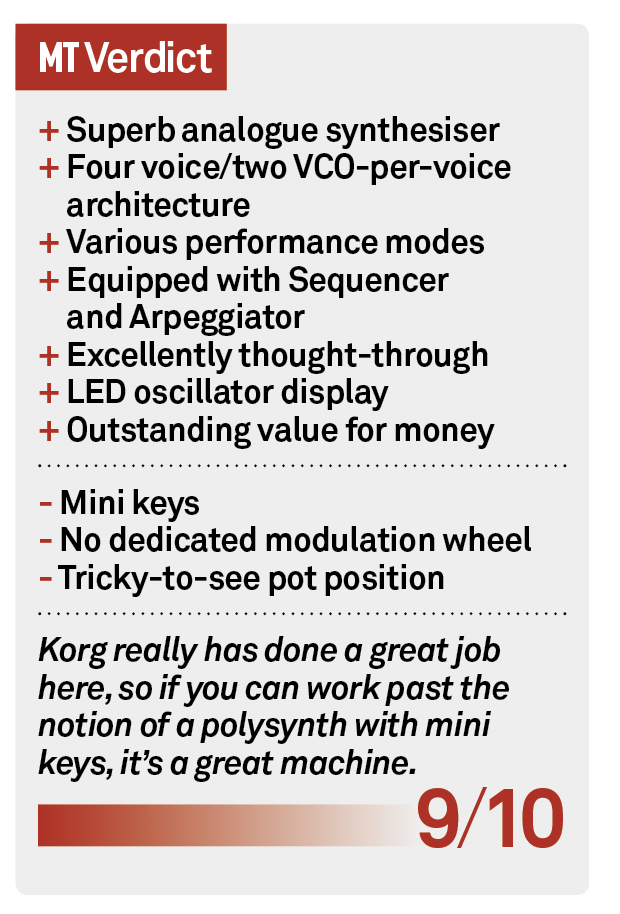
Korg minilogue v1.2 Features
● Four-voice polyphonic analogue synthesiser
● Full subtractive synthesis architecture
● Mono, Duo and Poly voice modes
● Arpeggiator and Polyphonic Sequencer
● Sync’able with other analogue devices